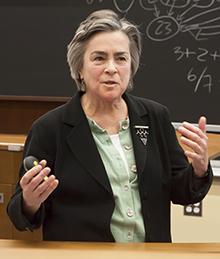Next Generation Compliance Strategy at the U.S. Environmental Protection Agency
Cynthia Giles, Assistant Administrator of the E.P.A. Office of Enforcement and Compliance Assurance, Discusses How the Federal Agency Is Promoting Better Compliance with Environmental Regulations
New York, March 16, 2015—The United States Environmental Protection Agency is pursuing innovative new strategies to encourage compliance and better enforce environmental regulations, said Cynthia Giles, assistant administrator of the agency’s Office of Enforcement and Compliance Assurance, in a Feb. 25 talk at Columbia Law School. She was introduced by Michael Burger, executive director of the Sabin Center for Climate Change Law.
“We are trying to protect companies playing by the rules from unfair competition against those companies who are breaking the rules,” Giles said.
| Cynthia Giles, assistant administrator of the U.S. Environmental Protection Agency's Office of Enforcement and Compliance Assurance |
Giles explained that the E.P.A. is promoting compliance through more effective rules, advanced technology for monitoring pollutants and toxins, electronic reporting and record-keeping, more transparency, and innovative means of enforcement. For instance, she said, the agency developed a program that looked for major violations in public water systems and gave them six months to comply or face enforcement, substantially reducing the number of serious violators.
“Pollution violations tend to be extensive and serious, outstripping federal and state capacity to regulate,” she said. “The costs of violations have to be greater than the costs of compliance.”
With the E.P.A. a popular target of budget cuts in Washington, Giles said straightforward rules and increased transparency are helping companies to comply and citizens to stand up for cleaner, greener communities.
“Regulators are not naturally inclined to simplicity, but people do better when things are clear,” Giles said. “We are finding ways to make the enforcement dollar go further.”
The talk was supported by the David Sive Memorial Fund, and co-sponsored by the Sabin Center, the Columbia Environmental Law Clinic, the Columbia Environmental Law Society, and the Columbia Journal of Environmental Law.
